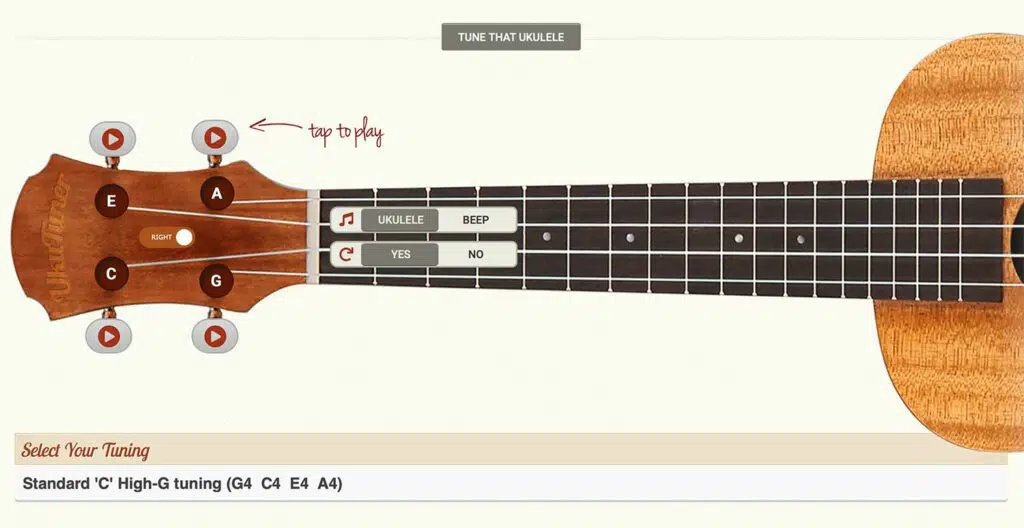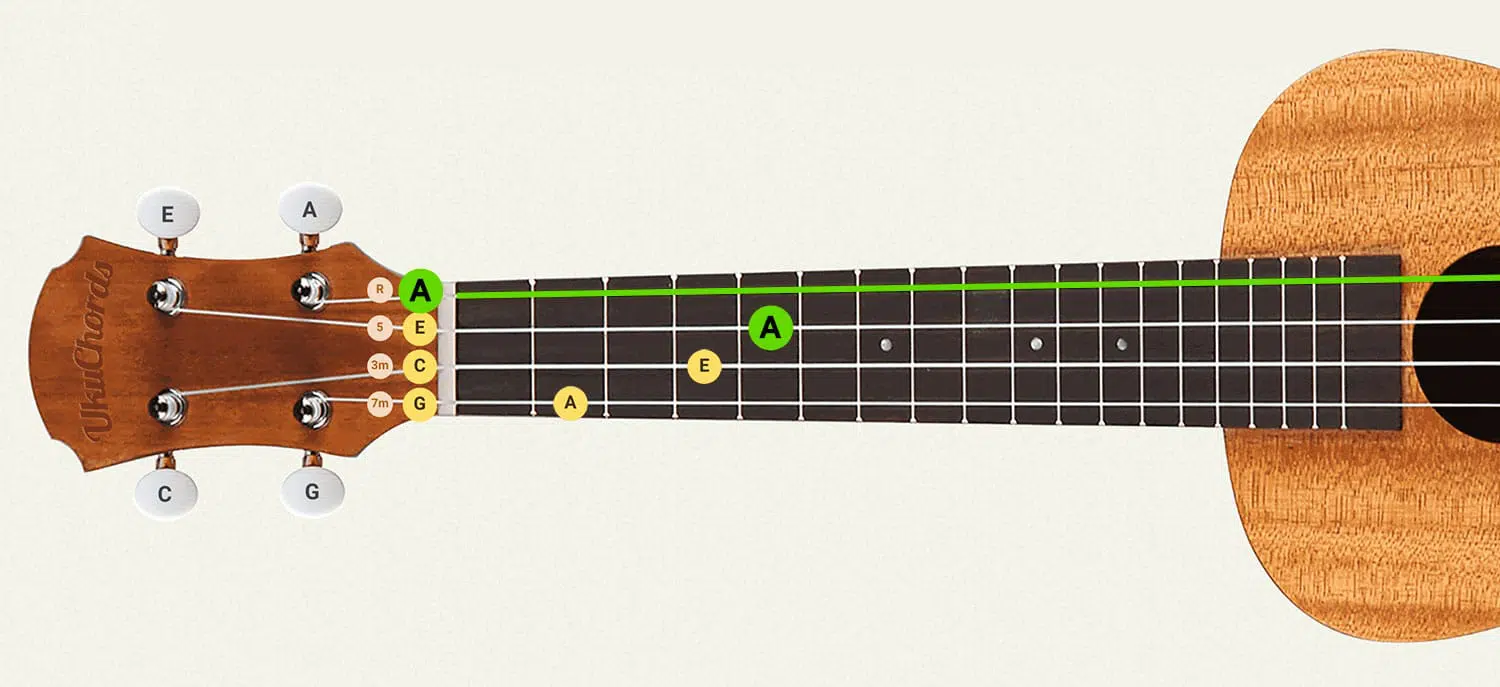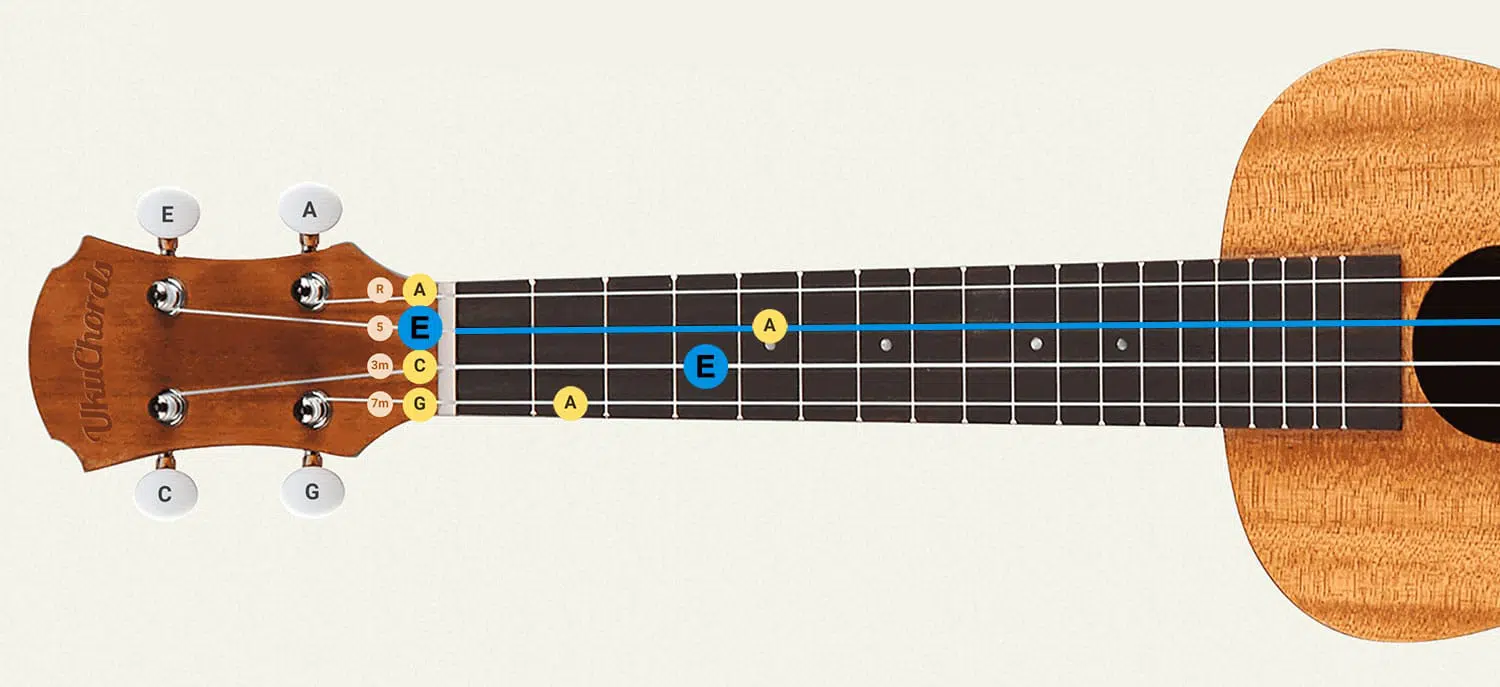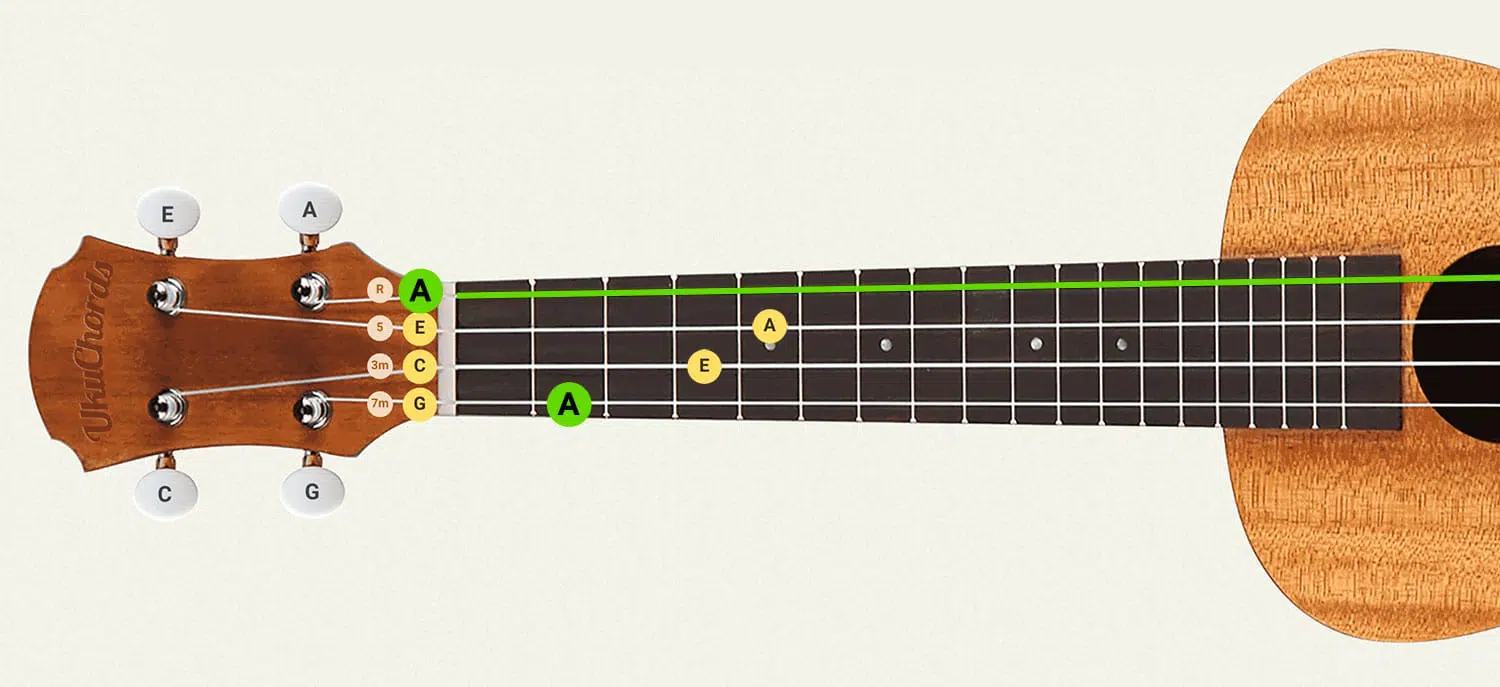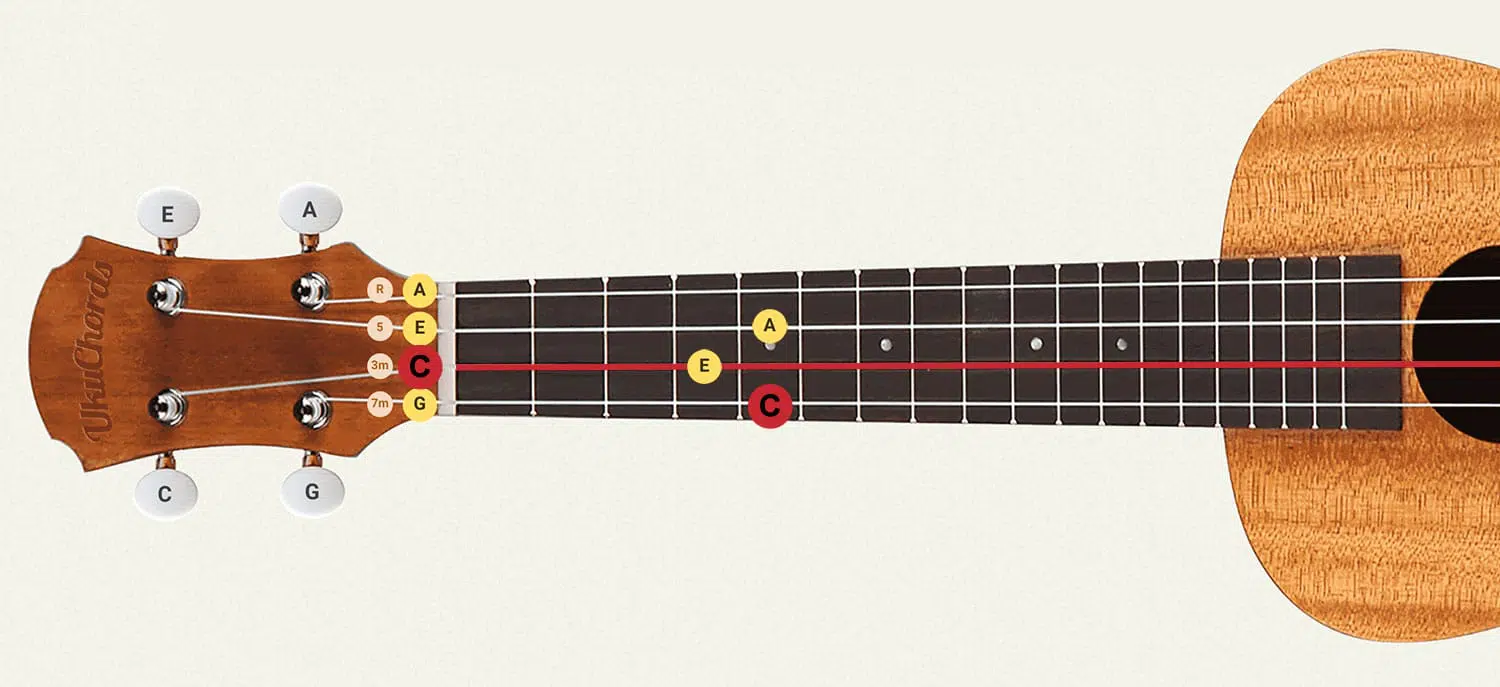So you already know about all the parts of a ukulele and you know how to restring an ukulele. Now what about tuning a ukulele? How on earth do you do that? Well, this guide will teach you how. After all, a well-tuned instrument is absolutely crucial if you want to play wonderful music.
First things first in tuning a ukulele: what are open strings?
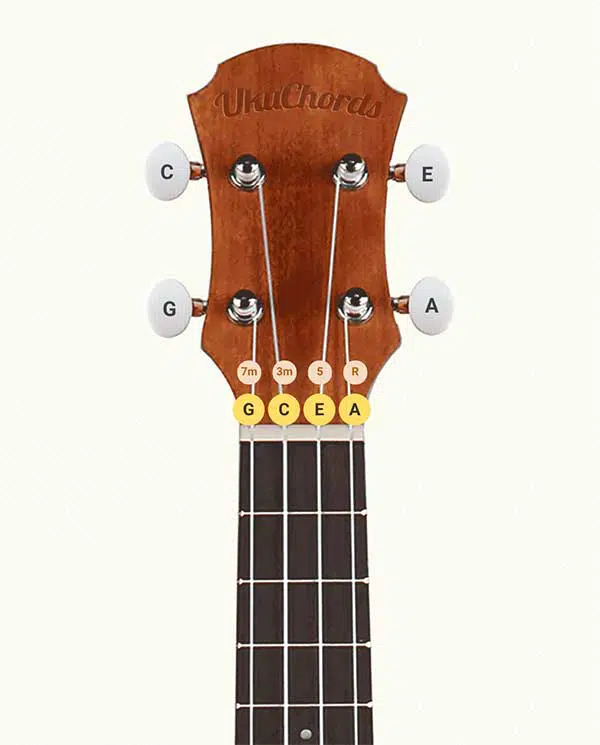
The open strings of the ukulele are as follows:
- G: 4th string (the furthest left on the fretboard)
- C: 3rd string
- E: 2nd string
- A: 1st string
This is when you have your ukulele in standard tuning, which is what you need to play most songs.
How to use UkuTabs ukulele tuner
The UkuTabs ukulele tuner supports the most popular ukulele tunings. Standard tuning is gCEA, which is the most common ukulele tuning. The tuning aDF#B (called D tuning) is shifted two frets, and brings out a sweeter ukulele tone. The dGBE tuning is more common for larger (baritone) ukuleles, and it will give you the same root notes as the top four strings on a guitar. Several other more exotic tunings are available as well. Here is an overview:
- Standard or ‘C’ or HighG or re-entrant tuning (G4 C4 E4 A4)
- Standard or ‘C’ or LowG (G3 C4 E4 A4)
- English or ‘D’ or soprano or 20th century standard tuning (A4 D4 F# B4)
- Baritone or ‘G’ (D3 G3 B3 E4 = four highest guitar strings)
- Canadian or ‘D’ or LowA (A3 D4 F# B4) (used by James Hill)
- Half-step down from standard (F# B3 D# G#)
- Full-step down from standard (F4 A♯3 D4 G4)
- Half-step up from standard (G# C# F4 A#)
- Full-step up from standard (A4 D4 F# B4)
Once you have selected a tuning, simply tap on the tuning pegs to ring out the root note for each string. Listen carefully and tune your ukulele to that note by ear. Some people find a monotone beep easier to tune to. Select ‘beep’ if you want to use that sound instead of the natural ukulele strings. Go check it now and get that ukulele in tune!
Electronic tuning
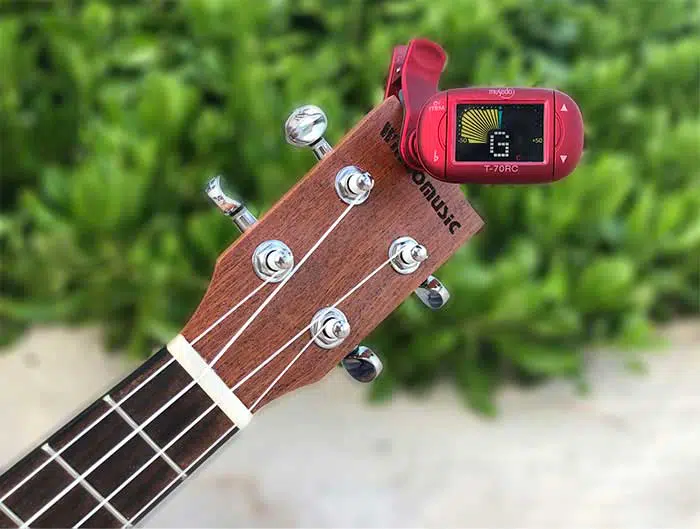
Using an electronic tuner is by far the easiest and most accurate way to tune your ukulele. The most popular electronic tuner is by far Snark SN6X clip-on tuner for ukulele or the Snark ST-2 multi-instrument tuner. They aren’t that expensive, typically around $10 – $15, and they will make your life a lot easier. When buying a tuner, make sure to choose one that is made to tune ukuleles such as the SN6X or go for a chromatic tuner (to tune different notes) such as the ST-2.
Tuning your ukulele with an electronic tuner is pretty straightforward. You put the tuner on your lap or clip it onto the headstock and pluck the strings. It will then show the note you are playing. Use the tuning pegs to adjust the tension of the string until you get the desired note.
Ukulele tuner apps for your phone
Can you use your phone to tune your ukulele? Yes you can! There are apps that basically use the same principle as electronic tuners. You can easily download them on your smartphone and there are tons of them for both iOS as android.
While the paid ones tend to be more user-friendly and can offer you different tunings, the free ones work the same way. This is very convenient for on-the-go tuning, and it can be a much cheaper alternative. Some popular tuning apps are: Pitched Tuner and gStrings Tuner.
Relative ukulele tuning method for tuning a ukulele
With relative ukulele tuning, all four strings are tuned relative to each other. This is a method you can use when you have no other means of tuning your ukulele. It is a good choice if you are playing on your own and you want to have all your strings sound right together, but it isn’t that accurate and might cause issues if you are playing with other people. The relative ukulele tuning method can be broken down into four steps.
- Start with the A string
You will use the first string (A) as a reference to tune the other three strings, which is why this method isn’t that accurate. You won’t notice any problems if you are playing alone, but you will if you play along with songs or with your friends.
- Adjust the E string
Place your finger just behind the fifth fret on the E string (second string). That note is an A. When you pick the first string (A), it should sound the same. Adjust the second string with the tuning pegs on the headstock until the two strings sound the same.
- Adjust the C string
Now place your finger just behind the fourth fret on the C string (third string). That note is an E. When you pick the second string (E), it should sound the same. Adjust the third string with the tuning pegs on the headstock until it sounds the same as the second string. By now you will have noticed that tuning a ukulele is kind of fun.
- high G relative tuning
Most ukuleles come with a high G string as standard. Place your finger just behind the second fret on the G string (fourth string). That note is an A. When you pick the first string (A), it should sound the same as the A on the G string. Adjust the fourth string with the tuning pegs on the headstock until the two strings sound the same.
- low G relative tuning
To tune a ukulele with a low G string, place your finger on the fifth fret on the G string (fourth string). That note is a C. When you pick the third string (C), it should sound the same. Adjust the fourth string with the tuning pegs on the headstock until the two strings sound the same.
It might take some practice to train your ear, but this is actually an easy way to tune your ukulele quickly. If you know your notes on the fretboard you could also come up with other combinations.
Piano Tuning
How do you go about tuning a ukulele with a piano? Play the notes G, C, E and A on the piano to match the G, C, E and A strings on the ukulele. If you use a low G tuning, you will need to play the G one octave lower.
You can see the keys of the piano in the diagram, along with the matching string note and string number at the top. Match the notes of the piano to those of your ukulele by ear. Getting the hang of this might take some practice.
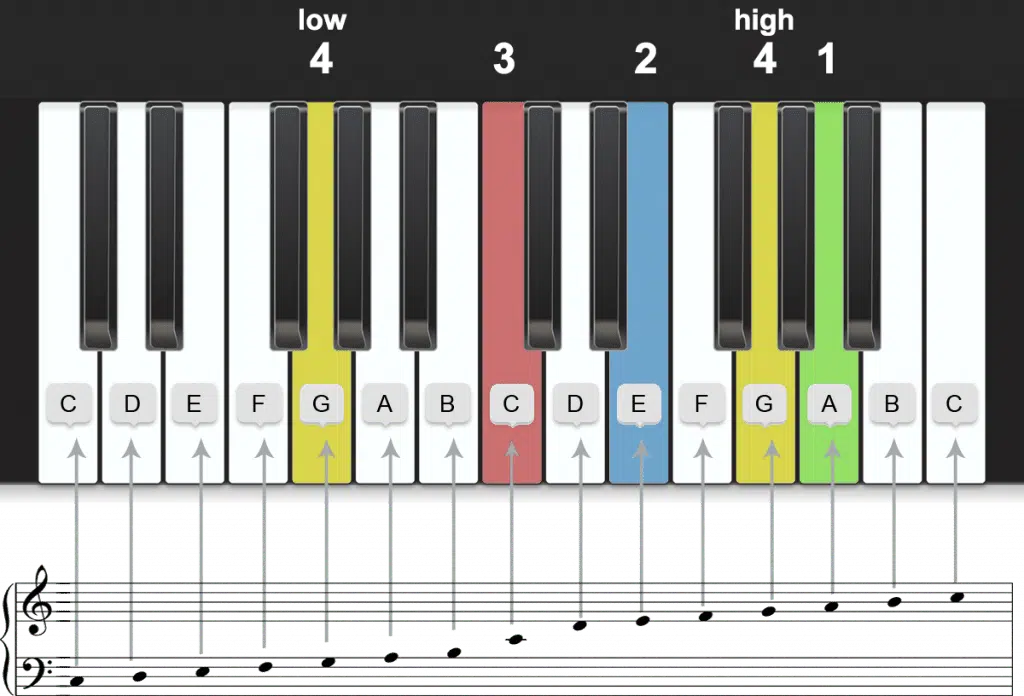
Can’t get it in tune?
If you have an older ukulele or a brand new one that hasn’t been set up properly, you might find that you can’t seem to get your ukulele in tune at all. You can probably solve this simply by tightening the screws on the tuning heads a little bit.
If your strings buzz when playing, take a look at how to fix that in our ukulele buzz fixing guide.
Another reason may be that the strings haven’t been put on correctly. Take a look at the guide to changing ukulele strings to find out how to do it right.
Need more input?
Feel free to contact me whenever you need more information about tuning a ukulele.
Also interested in knowing how to take care of your ukulele? Or perhaps want to know more about all the different types of ukulele tunings?

